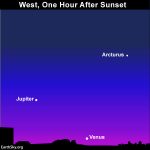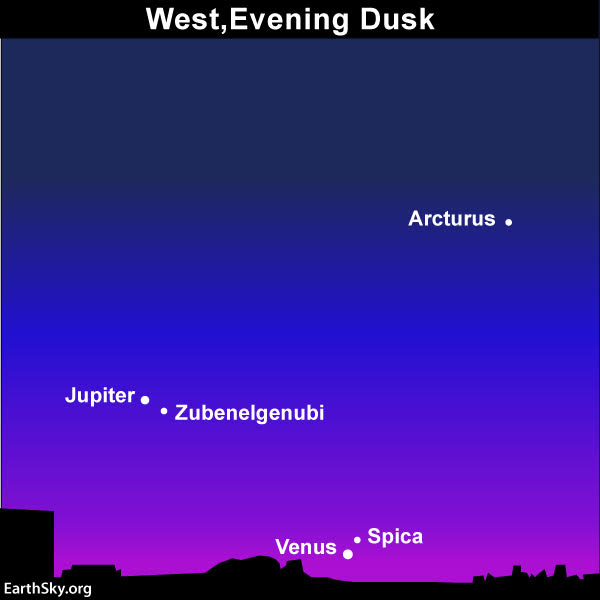
Throughout September, 2018, find an unobstructed horizon in the direction of sunset and watch for two brilliant planets and one bright star to pop out into the your western sky at dusk. In their order of brilliance, these bright beauties are the planets Venus and Jupiter, plus the star Arcturus. Given clear skies and an unobstructed western horizon, the gorgeous threesome – Venus, Jupiter and Arcturus – should be easy to view from most places worldwide.
The sky charts above and below are designed for around 40 degrees north latitude (United States, Spain, Turkey, Japan). If you live at far-northern latitudes, however, you might not see Venus. That’s because – for example – at 60 degrees north latitude (the latitude of Anchorage, Alaska), the sun and Venus set at about the same time.
From the Southern Hemisphere, you’ll see Jupiter more directly above Venus (rather than to Venus’ upper left). Moreover, Venus and Jupiter stay out considerably longer after sunset in the Southern Hemisphere than they do in the Northern Hemisphere.

If you can’t see the star Spica next to Venus or the star Zubenelgenubi next to Jupiter with the eye alone, try your luck with binoculars.
Arcturus is a different story altogether. From the tropical regions of the globe, Arcturus appears lower down in the sky, more to the right (rather than the upper right) of Venus and Jupiter. In early September 2018, at 20 degrees north latitude (Hawaii and Mexico City), Jupiter and Arcturus set about the same time; and at 20 degrees south latitude, it’s Venus and Arcturus that set at about the same time.
Farther south, in the temperate regions of the the Southern Hemisphere, Arcturus is found to the lower right of Venus. At these southerly latitudes, Arcturus sets before Venus does.
Have binoculars? Aim them at Venus and you might spot Spica, the brightest star in the constellation Virgo the Maiden, in the same binocular field together. Then aim binoculars at Jupiter to view Zubenelgenubi, the alpha star of the constellation Libra the Scales, taking stage in the same binocular field with Jupiter. (See sky chart above.)
Bottom line: Look west at dusk throughout September, 2018, for a bright celestial threesome. In order of brightness, they are Venus, Jupiter and the star Arcturus.
from EarthSky https://ift.tt/2wB4C6J

Throughout September, 2018, find an unobstructed horizon in the direction of sunset and watch for two brilliant planets and one bright star to pop out into the your western sky at dusk. In their order of brilliance, these bright beauties are the planets Venus and Jupiter, plus the star Arcturus. Given clear skies and an unobstructed western horizon, the gorgeous threesome – Venus, Jupiter and Arcturus – should be easy to view from most places worldwide.
The sky charts above and below are designed for around 40 degrees north latitude (United States, Spain, Turkey, Japan). If you live at far-northern latitudes, however, you might not see Venus. That’s because – for example – at 60 degrees north latitude (the latitude of Anchorage, Alaska), the sun and Venus set at about the same time.
From the Southern Hemisphere, you’ll see Jupiter more directly above Venus (rather than to Venus’ upper left). Moreover, Venus and Jupiter stay out considerably longer after sunset in the Southern Hemisphere than they do in the Northern Hemisphere.

If you can’t see the star Spica next to Venus or the star Zubenelgenubi next to Jupiter with the eye alone, try your luck with binoculars.
Arcturus is a different story altogether. From the tropical regions of the globe, Arcturus appears lower down in the sky, more to the right (rather than the upper right) of Venus and Jupiter. In early September 2018, at 20 degrees north latitude (Hawaii and Mexico City), Jupiter and Arcturus set about the same time; and at 20 degrees south latitude, it’s Venus and Arcturus that set at about the same time.
Farther south, in the temperate regions of the the Southern Hemisphere, Arcturus is found to the lower right of Venus. At these southerly latitudes, Arcturus sets before Venus does.
Have binoculars? Aim them at Venus and you might spot Spica, the brightest star in the constellation Virgo the Maiden, in the same binocular field together. Then aim binoculars at Jupiter to view Zubenelgenubi, the alpha star of the constellation Libra the Scales, taking stage in the same binocular field with Jupiter. (See sky chart above.)
Bottom line: Look west at dusk throughout September, 2018, for a bright celestial threesome. In order of brightness, they are Venus, Jupiter and the star Arcturus.
from EarthSky https://ift.tt/2wB4C6J

Aucun commentaire:
Enregistrer un commentaire